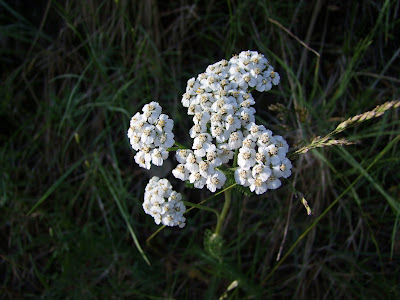Yarrow, along the Maligne Canyon trail, Jasper, July 2013.
Note the feathery leaves, too, divided pinnately into segments (not visible in the first photo). Very important for identification, because other white-flowered plants are very poisonous (e.g. water hemlock).
This is yarrow (Achillea millefolium).
Parts to use: leaves, flowers to a lesser extent
Uses: clotting wounds (esp. nosebleeds), easing menstrual blood, improving general blood circulation, treating colds (esp. with fever), treating internal bleeding (ulcers, etc.)
Yarrow—its cluster of whitish-green flowers, feathery
leaves, tough and grasping roots—is a plant very dear to me. Not only for its myriad
uses, but because it’s one of the very first plants my dad taught me to
identify. Yarrow grows extensively throughout Western Canada, in the
grasslands, parklands, mountains, and the boreal; it will also tenaciously takes over
roadsides and ditches (and gardens, when you buy those alpine wildflower seed
mixes…) and so we encountered it often on the trails we walked when I was young.
I happened to meet yarrow when in need of one of its key
healing qualities – it is high coumarins,
compounds which contain vitamin K, and thus has the ability to clot blood. I
used to get terrible nosebleeds when I was young, especially on hot dry summer
days. I remember standing in the shade on a lakeside, anxiously pinching my
nose while my dad brushed aside bushes nearby and gently plucked a few unfurled
yarrow leaves. He crushed them up first with his fingers, and then gave them to
me. “Just chew them up a little, get them wet with some spit,” he told me,
“that will activate them”. I did as told—the leaves were aromatic, spicy and
bittersweet. Then he rolled them up into a little pack, and placed them up my
nose. I was fascinated by this experiment. In about five minutes, my nosebleed
had stopped and I was left with a sweet earthy smell even after I removed the
mass of leaves. Intrigued, I paid even closer attention as he named the plants
and told about their many properties, and stories of times he’d used them out
in the bush.
And so yarrow always reminds me of my father, and the care he
took to teach my sister and me about what was growing around us, and how this
healing knowledge has remained with us. My sister, who lost interest early on
in camping and living outdoors, remarked recently that she did appreciated
these teachings nonetheless, and was pleased she could still pick out yarrow
when she saw it on the sides of the road.
Due to its aforementioned clotting abilities, yarrow is also called
‘woundwort’. The scientific name is Greek, after Achilles, because there are
stories that a centaur gave him the plant before he headed into battle.
Millefolium for a thousand leaves, and another name in English,
‘thousand-seal’. In medieval Western Europe, its flowers have been a
constituent of gruit (a beer flavouring mixture) and its young leaves a tender,
bittersweet spinach-like potherb.
My grandmother also knew yarrow (derevij or krivavnyk in
Ukrainian). Yarrow tea made using the fresh (or dried) flowers and leaves and
mixed with mint was good for colds, she said. Its anti-inflammatory properties
could help reduce a fever. Its styptic properties also helped with internal
bleeding, and could also ease bloody diarrhea ("People in the Old Country took
it," she said, as when she grew up in Western Ukraine, cholera epidemics were
still a great threat). My grandma drank tea from her garden yarrow to help with
a stomach ulcer as well. She told me that above all, yarrow is simply ‘good for
the blood’ and improved circulation. Most importantly, it can she first told me
about drinking plain yarrow tea as a remedy for regulating menstruation. Its
ability to regulate the blood means that it can help ease both heavy bleeding
and also stimulate a scant period.
To make a yarrow tea, you can use the leaves (and flowers –
but I usually just use leaves).
If it’s fresh, two long leaves will do it, and if dried, use
1 tsp. for each cup of boiling water. Steep it for 10 minutes either way (if
you cover the lid of the cup, you trap more of the goodness in). It becomes
bitter easily, so don’t oversteep it – be sure to strain out the leaves. Adding
a bit of lemon and honey can make it more palatable. Good for colds, fevers,
and also for reducing some of the pain and blood flow during a heavy period –
or bringing on a stubborn one.
And, as noted, you can use the dried powdered leaves to stop
bleeding as well, but fresh chewed leaves do work just as well and can be
pressed again cuts and wounds (alone or as part of a poultice) as well as
placed in the nostril as I found out early on. It has never failed me once.
*Some notes of warning – I’ve heard of a few people who have had skin
reactions to yarrow (potentially due to taking drugs that cause
photosensitivity), so be cautious of that.

